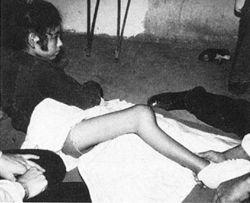Hesperian Health Guides
How to Correct Contractures Using Adjustable Braces
HealthWiki > Disabled Village Children > Chapter 59: Correcting Joint Contractures > How to Correct Contractures Using Adjustable Braces
Orthopedic suppliers in some countries sell knee and ankle joints that can be locked in different positions. But these are very expensive. However, a skilled village craftsperson can put together something similar:
| Knee and ankle joints can be adjusted every few days to gradually straighten the joints. | Space the holes on the 2 pieces differently so that lining them up allows a range of small adjustments. |
 |
 |
| leather or plastic cuffs | adjustment screw or pin |
A much simpler low-cost model can be made of round or flat metal bar.
Two designs for adjustable braces to correct ankle contractures
| 1. | ||
| wood wedges of different widths | notch to grip rod | |
 |

wood stop
Fit different wedges between stop and rod to change adjustment.
Add a wide, well-padded ankle strap. | |
| 2. |  |
 |

wide strap
soft pad |
| Bend the rod tips like this. | Bolt them tightly between 2 layers of thin wood. | Bend rods up a little more every few days. | |
Note: This design is complicated to make, but can be adjusted while the brace is on the child. | |||
An adjustable wood brace for knee and ankle contractures
 |
 |
Using “wing nuts” makes it easier to remove the bolts for clamping the position of the cross pieces. | |
| The positions of these 2 cross pieces can be changed to adjust the angle of the knee and foot. | Use thin pieces of hard wood about 2 cm. wide and 6 to 8 mm. thick. | ||
WARNING!






